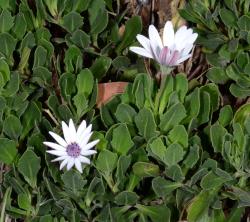- Taxon
- Weed
- Gallery
- ≡ Calendula fruticosa L.
- ≡ Osteospermum fruticosum (L.) Norl.
Straggling, glandular perennial herb, becoming woody toward base, often forming dense mats. Stems glabrous or clothed in short hairs and becoming glabrous, procumbent, ascending at tips, rooting along ground. Lvs alternate, moderately clothed in short, erect hairs, fleshy, narrow-elliptic to obovate, acute, mucronate, cuneate to the ± amplexicaul base, irregularly dentate or denticulate with 3–7 teeth on each side, 5–10 × 1–2–(3) cm; lvs near capitula becoming smaller, narrower, often almost lanceolate or linear, with fewer teeth or sometimes entire. Capitula solitary, 4–7 cm diam. Involucral bracts in 2 rows, sparsely to moderately hairy, ciliate, lanceolate, 12–15 mm long. Ray florets 14–20; ligules white on upper surface, bluish mauve and often lined on lower surface, sometimes tinged green, (1.6)–2–3 cm long; disc florets numerous, dull bluish purple, with glabrous lobe apices. Achenes obovoid, glabrous, 3-angled, faintly reticulate and with central rib between angles, 6–7 mm long.
[From: Webb et al. (1988) Flora of New Zealand. Volume 4. as Osteospermum fruticosum (L.) Norl.]
Flowering: Aug.–Jan.




